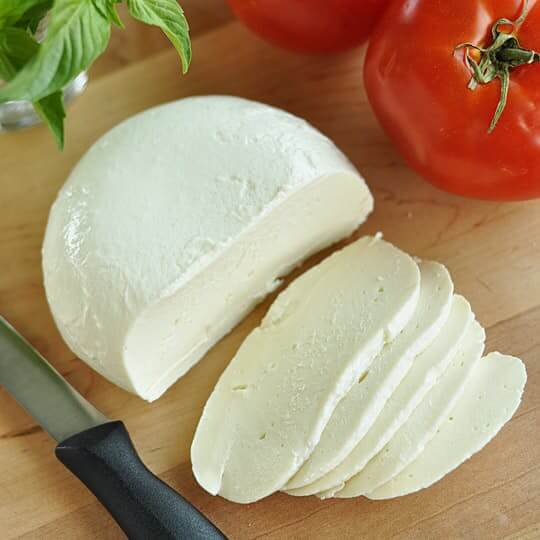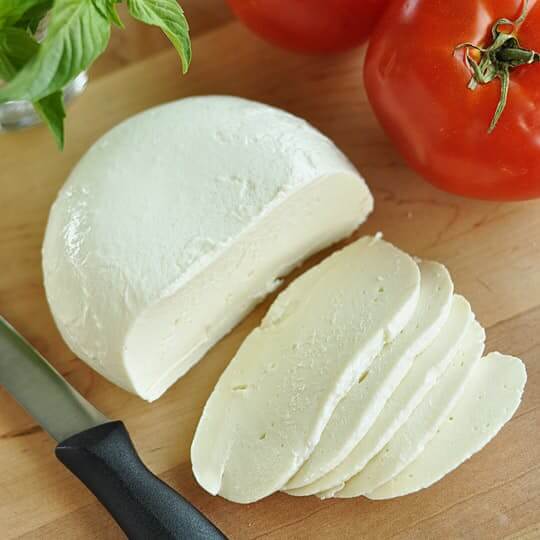
Mozzarella Recipe with Instant Nonfat Dry Milk
-
Yield
2 Pounds
-
Aging Time
None
-
Skill Level
Beginner
-
Author
Jim Wallace

Ingredients
Total price for selected items: Total price:
Instructions
Selecting Powdered Milk and Cream
This recipe for Mozzarella involves adding cream to Non Fat Dry Milk Powder. We've had great luck using "Carnation" brand milk here so if you're having problems with other brands give this one a try. We've used many other brands along the way that also work well.
Note: UltraPasteurized cream is fine to use since the calcium and proteins for the cheese are already in the milk. To make the milk, mix 1 pint of cream with 7 pints of Dry Milk Powder for one gallon of milk.
Below are is a list of the final fat % in 1 gallon of milk for varying types of cream:
| Cream Type (1 Pint) | Cream % | Fat % for 1 Gal Milk |
|---|---|---|
| Double (rich) Cream | 48% | 6% |
| Heavy Whipping Cream | 36-40% | 4.5-5% |
| Light Whipping Cream | 30-36% | 3.7-4.5% |
| Light or Coffee Cream | 18-30% | 2.2-3.7% |
| Single Cream | 20% | 2.5% |
| Half and Half | 10.5% | 1.3% |
The higher the fat content, the more difficult it is to retain the fat in the final cheese but the better the flavor. When using a higher fat % the whey will be somewhat milky looking. You can minimize this by treating the curd very gently at all stages.
Since your mix for this cheese is 7 pints of milk to 1 pint of cream you can either follow the package mix directions for 1 gallon and drink the 1 pint of Non Fat Milk you remove to make room for the cream addition or simply multiply the total dry milk powder needed by .875 (7/8ths of a gallon) to make just the 7 pints. This will leave room for your pint of cream. The easiest thing for us is to add 2 quarts of cool water with the dry milk powder in a clean container and stir until the powder dissolves, then add this to an empty sanitized gallon jug. The 1-pint of cream can now be added and then the jug topped up to 1 gallon with cool water. Refrigerate this overnight and you have one gallon of great milk to make your mozzarella.
-



Prepare Ingredients
Collect and sanitize all of your equipment and gather the ingredients.
A 2 gallon pot for the milk, a long knife, a colander, a couple of bowls, measuring cup, and slotted spoon plus the ingredients and thermometer that came in your 30 minute mozzarella kit are what should be in front of you now.
Next add 1/4 rennet tablet or measure 1/4 tsp. of liquid rennet into 1/4 cup of cool water and set aside. Try to cut the tablet as carefully as possible into quarters but it does not always work out that way. No worries- just do the best you can. You may notice that this does not dissolve totally but it is OK. Simply add the entire mix when adding rennet.
Then measure out 1.5 tsp. of citric acid into a 1 cup measure of cool water. Make sure that this is stirred until it all dissolves.
-



Acidify & Heat Milk
Your next step will be to add the citric acid to the milk. This will increase the acid and is responsible for the final stretch of the mozzarella. It will also assist the rennet in forming the curd.
Pour the citric acid solution you prepared above into the cold pot and then quickly pour the milk on top of this. It is very important to stir well as you do this to prevent any localized coagulation which will appear as curds floating to the surface. There should be little to no curds forming at this stage.
Next, begin to heat the milk slowly at medium heat to 90-92°F. Stir well enough to keep the milk from sticking/scorching. We usually turn the burner off a degree or two before we reach our final temp to keep from overheating. The milk always seems to coast up that last few degrees.
-

Coagulate with Rennet
At 90-92°F add the 1/4 tsp rennet or 1/4 rennet tablet dissolved in 1/4 cup water and stir for 20-30 seconds. Then allow the milk to rest at this temp totally still for coagulation. Initial firming of the milk will take place at about 2-2.5 minutes but allow the milk to firm a full 7-10 min. before cutting.
-




Cut Curds to Release Whey
Once the curds form cut them into a checkerboard pattern of 3/4 -1 squares (larger for moister mozzarella). Wait 1-2 min. then very gently (curd is very soft at this point still) cut horizontal layers with ladle or spoon. Result should be as equal in size as you can manage.
NOTE: The longer the curd is stirred at this point and the higher the temp (95-105°F), the drier the final cheese will be because the heat causes more whey to be released.
The curd at this stage will hold a good shape but these are very fragile (see what happens if you drop one on the floor). Stirring should be very gentle until they have been cooked for a while.
-


Remove Whey
Once the curd forms well and seems to be releasing whey it is time to separate the curds from whey. Allowing the curds to settle and consolidate for a minute or two will initially separate the whey.
Then the excess whey that rises can be poured off while holding the curds back with your hand. The curds should now be carefully transferred to a bowl with a spoon or perforated ladle (best). Further whey separation can now be done by pulling the curd back to the center of the bowl. You will see more whey running off at this point and this should be removed. Once the curd begins to consolidate well it is time to heat the curds to develop the stretching character of mozzarella.
-


Heat the Curd
Choose one of the following methods to heat the curds:
A) Our 30 minute system is quicker because we simply use 3 cycles in the microwave to heat the curds to the point of stretching.
- The first stage of 60 seconds on High will cause more whey to be released as the curds heat. The cheese is removed and folded back on itself several times releasing more whey which is removed.
- The next step is back into the microwave for 30 seconds on High. This will now cause the curds to consolidate more and begin to stretch. Folding and removing whey now have your cheese looking more like mozzarella. At this point the cheese may simply stretch of its own weight.
- The final cycle is again 30 seconds and your cheese should now be stretching well. Following this cycle it may be too hot to handle so using gloves or a pair of sanitized wooden spoons will help.
B) Traditional hot whey or water for stretching.
This is more in line with the traditional process but takes a bit more time. 2 quarts of water or whey are heated to 175F. This will be too hot for your hands so use heavy rubber gloves or a couple of sanitized wooden spoons to manipulate the curds. The curd you have made is now placed in the water and folded back and forth on itself to distribute the heat. This may take 3-5 minutes and you should note that the curd is ready to stretch on its own when it is ready.
Click HERE for a detailed description of this process without using a microwave.
As the curds are heated note the whey that has been released as the curds are heated. Quickly as in the previous step, press/knead the curds while pouring off the whey. Do this several times.
NOTE: the more you press the curds during this phase the more whey will be removed and the drier the cheese will become. This is a matter of personal preference and with experience you will be making the perfect cheese to your own taste.
-



Stretch the Curd
The Mozzarella should now be ready to stretch. Begin by allowing the cheese to stretch under its own weight as in the photo to the left. Once your mozzarella begins to stretch you can now give it the characteristic smooth texture of mozzarella by stretching and folding the curds like taffy. If the cheese begins to stiffen up and resist the stretch, reheat it in the microwave or in the hot water.
The more times you do this the smoother it will become. This is also the point where you add the quantity of salt you like (1/4-1/2 tsp. should be good to start with) to the cheese as you stretch it. In Italy this is the point where they become creative and shape little pigs and cows from the fresh cheese.
Here is also where you need to exercise restraint to keep from playing with your food.
Once you are happy with your cheese you can form it into a nice round ball to chill and store.
-



Chill & Salt
It is now time to cool the cheese to retain its shape. While warm the cheese will simply slump into a flat disk. Once you have formed the cheese as you wish, it should be dropped into a pan of ice-cold water. You can also drop it into a cheese form or small plastic container to hold its shape. An hour or so here should cool it through. Then move it to the fridge for further cooling. If it sits in the cold water too long the surface of the cheese will soften too much and salt will be pulled from the cheese.
Cheese Making Supplies
Related Products
You May Also Like




































